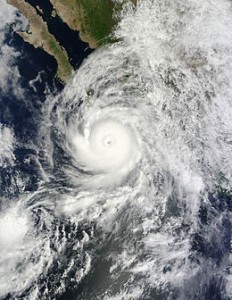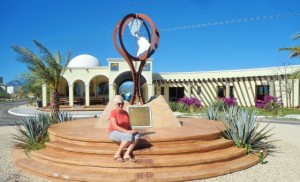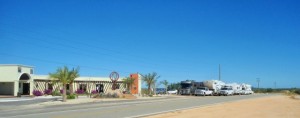
November 26, 2014 – Leaving Loreto we drove to Ciudad Constitucion and encountered road construction as you reach the summit and start the long decent into Ciudad Insuregentis, slow but necessary, only a small section of construction remains on the road west to town now. We stopped for fuel and our shop at Super Ley, always great produce and a great bargain on Wine (3 for 2). Then off to Palapa 206 owned by Mike and Bertha, all is good with the family including the boys, Nigel & Paclo. Nigel is in a race Saturday night, and Paclo seemed calmed down now that he turned 6. We enjoyed an impromptu happy hour at Chris & Dixie’s trailer and turned in early. John & Becky (Baja Winters) were already there, 1 day ahead of schedule, they only have 1 RV with them for their fall drive to Los Barriles. The next day everyone was up early then off to Playa Tecolote. We encountered 3 sections of new road bewteen Palapa 206 and Santa Rita, all about 5 km (3 miles) long, odd but enjoyable. The last 50 km (30 miles) we hit 3 sections of road construction, 1 on top of the plateau and 2 down below as you approach La Paz near sea level. Washboard was the order of the day for our first encounter, the other two had cleary seen a Grader recently. Short term pain for long term gain I say, Hwy 1 will be much improved when these sections are complete.

We arrived at Playa Tecolote a little later than usual, about 1, the wind was up and beach had survived Odile without a scratch, it actually looked better than expected, although a number of Palapa had been damaged. The French folks we had met early on Day 1 and Playa Santispac were already set up and the kids swimming in the ocean, Alex & Roxanne were caching the ferry the next day to continue their journey to the tip of South America. As we were setting up Bill & Marilynn showed up to say hi, they are staying in Campestra Maranatha this season after 15 years on the beach at Tecolote, quite a change. Once we got parked it did not take long for folks to jump in the water and enjoy the warm ocean currents and breezes with a cold refreshment in hand. We awoke the next day to less wind which had dropped substantially. Some folks were in the water early however the Kayak & Paddleboard stayed on the roof as the sea was still not calm enough for those activities. Later some folks headed into town and the rest enough just R & RD. It was 25C (75F) when we awoke and reached a daytime high of 30C (82F).

We had our Potluck on Day 2 on the beach hosted at Gary & Cheryl’s trailer, great selection of grub which everyone enjoyed, shared a few stories around Gary & Cheryl’s propane campfire, we had lots of laughs for sure. One more morning on the beach and the surf was up as was the wind, nothing we had not experienced before. Took the dogs out for a walk and saw that the sea was up to the Palapas but no further, we have been on this beach 50 times in the past 10 years and have seen everything from hunker down wind to glass like lake conditions. About 8 AM that started to change, suddenly the ocean was coming onto the beach where some of the group were camped out, then filling in behind with water. After about 40 minutes of this Lisa & I went for a quick walk to survey the situation and decide it was time to Adios Amigos! No point getting stuck or stranded as our escape routes off the beach quickly flooding. Within 45 minutes we were headed on our way to Rancho Verde and a great lunch stop with Mark at the El Triunfo Café, wind a waves a distant memory.

We got settled in Racho Verde late in the afternoon, the mountains are just beautiful after so much rain from Odile. Some folks took a walk about, others rode their bikes, everyone had a great night’s sleep serenaded by the crickets and cool air. We left at 9 AM the next day headed for the bottom, Lands’ End AKA El Arco. Stopped for our body break and photos at the Tropic of Cancer then onward to Caligas to top up the gangs propane. At that stop we discovered that Randy & Liz had blown a hose for their slide. Chris and Les jumped in to lend a hand and we got back on the road. As we entered San Jose del Cabo the evidence of the Chabasco Odile damage was still very visible as was the ongoing cleanup and repair. The palm trees thru the Hotel corridor from San Jose to Cabo all looked like someone had taken a weed eater to them, not nearly as lush as usual. Lots of hotels in repair for sure. Arrived at WalMart for shopping, lunch, banking and other shopping then off to Villa Serena. After setup Randy, Chris & Les headed out to contact of Chris’s to purchase a new hose. A few of us headed over to Vag’s for dinner and Chris & Randy remained behind to work on the repairs for the A Class. We had lots of fun and a great time at Vag’s as always, Peter is always such a great host.When we returned we saw that the slides were out, not sure if the repairs are 100% complete.
This morning we are off to San Jose Del Cabo.

Did you know?
Hurricane Odile was the most intense land falling tropical cyclone on the Baja California peninsula during the satellite era, alongside Hurricane Olivia in 1967. Odile made landfall near Cabo San Lucas as a Category 3 hurricane at 04:45 UTC on September 15 with winds of 125 mph (205 km/h), prior to making landfall the winds were recorded at 130 mph (215 km/h). These wind estimates tie Odile with Hurricane Olivia in 1967 as the strongest tropical cyclone to move ashore Baja California Sur. Sweeping across the peninsula in September 2014, Odile inflicted widespread damage, particularly in the state of Baja California Sur, in addition to causing lesser impacts on the Mexican mainland and Southwestern United States. The precursor to Odile developed into a tropical depression south of Mexico on September 10 and quickly reached tropical storm strength. After meandering for several days, Odile began to track northwestward, intensifying to hurricane status before rapidly reaching its Category 4 hurricane peak intensity on September 14. The cyclone slightly weakened before making landfall near Cabo San Lucas with winds of 125 mph (200 km/h). Odile gradually weakened as it tracked across the length of the Baja California Peninsula, briefly tracking into the Gulf of California before degenerating into a remnant system on September 17. These remnants tracked northeastward across the Southwestern United States before they were no longer identifiable on September 19.

Odile was initially forecast to curve out to sea, avoiding land as it tracked westward. As a result, minor weather alerts were posted by the local governments of southwestern Mexico. However, precautionary measures on the Baja California peninsula began in earnest after Odile unexpectedly took a direct course towards the peninsula. A state of emergency was declared for several municipalities and 164 shelters were opened with a total capacity of 30,000 people. Due to the unanticipated threat of Odile, approximately 26,000 foreign tourists remained on the endangered peninsula at the time of landfall.

The combination of heavy rainfall and storm surge associated with Odile’s initial development off the southern coast of Mexico led to minor coastal damage across southwestern Mexico and three deaths in Oaxaca and Jalisco. The bulk of impacts associated with the hurricane occurred on the Baja California peninsula, where damages amounted to approximately MXN$15 billion (US$1.1 billion). Power outages spurred by Odile’s intense winds and rain cut electricity to 92% of the population of Baja California Sur. Severe flooding also occurred, causing rivers to swell and the mass evacuation of people out of hazardous low-lying areas. The remnants of Odile brought rains and unseasonably powerful thunderstorms to the southwestern United States. In total, Odile led to the deaths of 15 people throughout its nine-day existence. In the aftermath of the storm, thousands of stranded tourists were left to fend for themselves in their hotels with no information about how to get home. All internet connections and phone lines were down, tens of thousands of tourists couldn’t even contact their families to let them know they were ok. Most tourists had to chance it and go to the airport to try to get a flight out. At the airport there were thousands of people waiting in over a mile long line on the freeway to get on a flight out of Los Cabos with the average wait time was 8 hours in the hot sun. Widespread looting in impacted regions led to the declaration of martial law in some areas.

Despite the presence of land, only gradual weakening occurred after Odile made landfall. However, the Baja California peninsula’s mountainous terrain began to take its toll on the hurricane, weakening it down to a tropical storm by September 16. Although the storm’s convection was thinning out, Odile retained a well-organized satellite appearance and occasional bursts of thunderstorm activity. On September 17, a nearby mid-level ridge steered the system slowly northeastward, moving Odile into the Gulf of California as a moderate tropical storm. Despite the very warm waters of the gulf, the emergence of wind shear and land interaction offset otherwise favorable conditions. Odile continued to weaken as its convection sped northeastwards into Mexico and the southwestern United States; at 21:00 UTC on September 17, the NHC determined that the tropical storm had degenerated into a remnant area of low-pressure inland over northwestern mainland Mexico. The remnant circulation of Odile continued to track northeastward, entering extreme southeastern Arizona by 09:00 UTC on September 18. This circulation dissipated by September 19, just east of the border between Arizona and New Mexico, leaving behind a marked mass of thunderstorms which persisted across the region for the next several days.

Early Preparations
Shortly after formation, a “yellow” alert was issued for western Michoacán, while a “green” alert was issued for the rest of the state, Colima, and Jalisco. A “blue” alert was in effect for Nayarit, Oaxaca, and Guerrero. When the hurricane abruptly veered towards Mexico, the Baja California Peninsula was placed under “red” (maximum) alert. A state of emergency was declared on September 14 in La Paz, Los Cabos, Comondú, Loreto and Mulegé. In Cabo San Lucas, 2,100 marine workers were set up to start evacuations. In La Paz, classes were suspended and the city’s airport was closed. Throughout the peninsula, 164 shelters were opened, which can accommodate 30,000 people. However, only 3,500 persons used these shelters. At the time of landfall, hotels in the state were at 46% of capacity, equal to 30,000 tourists, 26,000 of which were foreigners. The ports of La Paz, Los Cabos, San José del Cabo, and Loreto were closed. Elsewhere, 214 people were evacuated to shelter in Sinaloa. Moreover, much of southern Sonora was placed under a “yellow” alert, while a “green” alert was in effect for the central part of the state. On September 15, the “yellow” alert was upgraded to a “red alert” while classes were canceled in 34 municipalities. After entering in the Gulf of California, a “red” alert was declared for Hermosillo.

Odile Casualties, Damage and Impact
Heavy rains partially associated with the storm brought flooding to Oaxaca resulted in two fatalities; a 9-year old was swept away in a river while a company worker was struck by lightning. Due to a combination of high waves and storm surge, 69 buildings in Acapulco were damaged, including 18 restaurants and a portion of a scenic walkway. Along the beaches of Nayarit and Colima, minor damage was reported. On the beach in Puerto Vallarta, two people were killed due to high waves.

After making landfall on Baja as a major hurricane, Odile brought widespread damage; many trees and power poles were down, blocking many roads. At least 239,000 people were left without electricity throughout Baja California Sur alone, equal to around 92% of the state’s population. The immediate effect was all flights in and out of the peninsula were cancelled. In Los Cabos alone, approximately 3,000-4,000 persons were stranded due to the cancellation of 44 flights. The airport in San Jose suffered substantial damage, particularly the newest addition. Throughout the peninsula, 30,000 vacationers were stranded which including 26,000 from other nations, mainly from the United States, Canada, and the UK, were evacuated to shelters. By September 16, many tourists were airlifted to surrounding airports, including Tijuana, Mazatlán, Guadalajara, and Mexico City, although one person perished on a flight back due to a heart attack due to the stress the storm created. Officials estimated that it would take 10 days for the Los Cabos airport to fully re-open. In the aftermath, looting was reported, and martial law was declared.

Offshore, eight fishermen were rescued, in Cabo San Lucas, many trees and poles were downed and 135 people were hurt. The city of San José Del Cabo sustained severe damage from the hurricane, where drinking water and communication services were lost. Along the La Paz harbor, 22 boats were damaged and four others were initially listed missing at sea. Five people were directly killed due to the hurricane on the peninsula, including a 62 year old man that died in Santa Rosalia while trying to cross a river, 2 Korean executives who attempted to cross a flooding arroyo in a vehicle and a man who died of a heart attack in La Paz. Overall, over 11,000 people were evacuated due to flooding. A total of 2,180 power poles were downed, including 800 in the Los Cabos area within a week CFE had 1500 employees on the ground making repairs in the entire region. Total damages from Odile are expected to be at least $15 billion pesos ($1.1 billion USD).

Our good friend Peter Cashmore who resides in Cabo San Lucas was visiting Vancouver when Odile came ashore. Peter & his business partner Joe Borbolla own & operate the Vagabundos Del Mar Trailer Park Restaurant and reside Vags. The early reports were grim however the restaurant did survive, his trailer did sustain heavy damage. Our other friends like Geraldine, Dennis & Gwen, Rick & Ronnie fared somewhat better. Bobby & Wendy over in Pescadero who operate Las Palmas Tropicales, Beachfront Vacation Rentals, were flooded badly and are still cleaning up.

On the eastern side of the peninsula, in the Bahía de los Ángeles area, 90 families were homeless due to floodwaters 1 m (3.3 ft) deep. Following the disaster, about 500 workers were deployed to provide 2,000 groceries to victims. That town was isolated when the hurricane destroyed the only road in. Our favourite RV Park, Barisa Marina sustained so much damage it is now closed. We have been staying there in 1985 and the resulting floods took sections of the park into the ocean.
Antonio & Bety Resendiz who formally operated the turtle research station survived intact, as did Al Perrett, George Lea, Keith and others at Daggett’s. After making its final landfall, the storm brought heavy rains to the northeastern part of the country. In Monterrey, four people perished, three of which died along the outskirts of the city in a car that was attempting to cross a creek; two children were also missing in this incident.

Effect on United States
The remnants of Hurricane Odile caused damage across central and eastern San Diego County, generating high winds and several uncharacteristically powerful thunderstorms in the region. Gusty winds uprooted trees, felled branches, cut power lines, crushed several cars, and flipped at least one airplane at Montgomery Field Airport. A sheriff deputy died in Texas and an oil field worker died in New Mexico as a result of flooding from Odile. There was also heavy rains and flooding in both Nevada and Arizona, resulting in the US I-15 into Las Vegas being severed for a period of time.
In short, Hurricane (Chubasco) Odile was a monster. To put that in context Baja Mexico varies between 80 KM (50 Miles) and 200 KM (150 Miles) wide, Odile was 600 miles wide.



